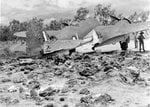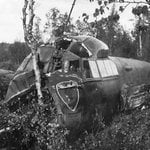N4521U
Plastic Pirate
It's a Spitfire Mk1a of 65 Sqn in early 1940, possibly at Hornchurch in February, when Official and Press photographers did a 'photo shoot'.
At that time, the 'official' harmonization range for guns was 250 yards, although some experienced pilots of rank higher than, say, Flying Officer, had their guns harmonized at shorter ranges, which, eventually, became 'official'.
A bore sight was used on each gun, which was then aligned and adjusted onto the centre of the cross on the target discs on the hangar doors, which were positioned to correspond with the equivalent desired range at the required angle. Note the lower target disc, which would be used for the next outboard gun, or guns, depending on how many discs were used per wing and per pair of guns.
The guns would then be adjusted to give a concentrated spread of fire across the approximate wingspan represented by the positioning of the discs, with the mpi on the centerline between the pairs of discs on either side, representing the fuselage area of the target aircraft, with the area of the 'spread' being set by requirements. This could be by experience or preference, but within the official guidelines of the period and, on average, would concentrate strikes within an area approximately five to fifteen feet across for all eight guns, allowing for convergeance and subsequent 'cross over' spread.
This could allow for a 'hosing' effect, probably the most common, given gunnery skills of the average pilot at that time, or for a concentrated, tight pattern at the convergeance point.
Exactly what I was after........ for general knowledge only. Thanks for that.




